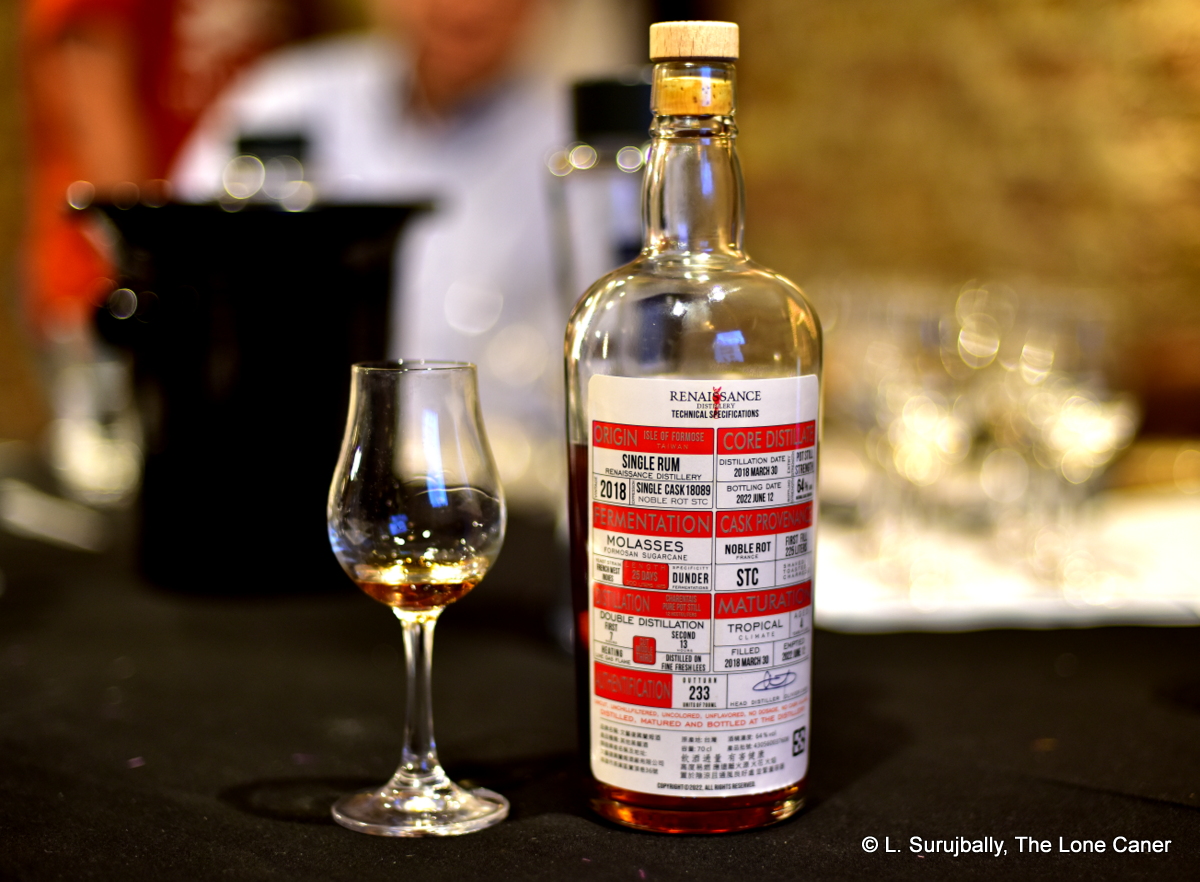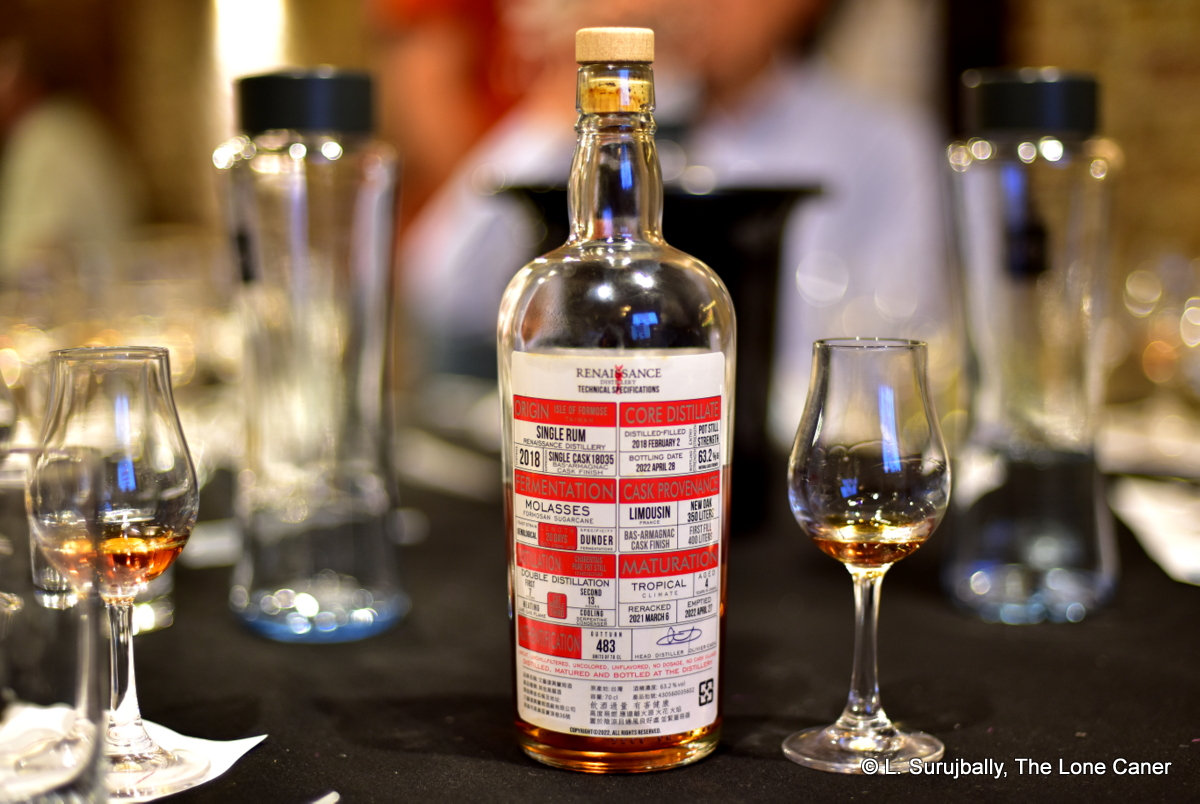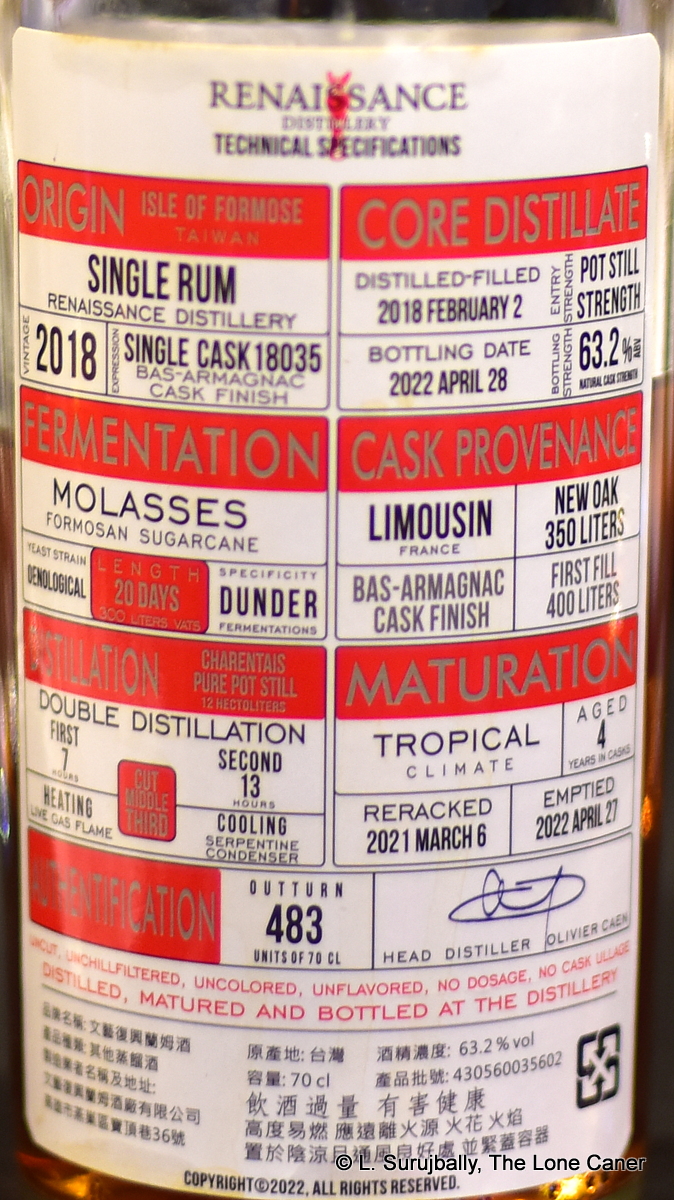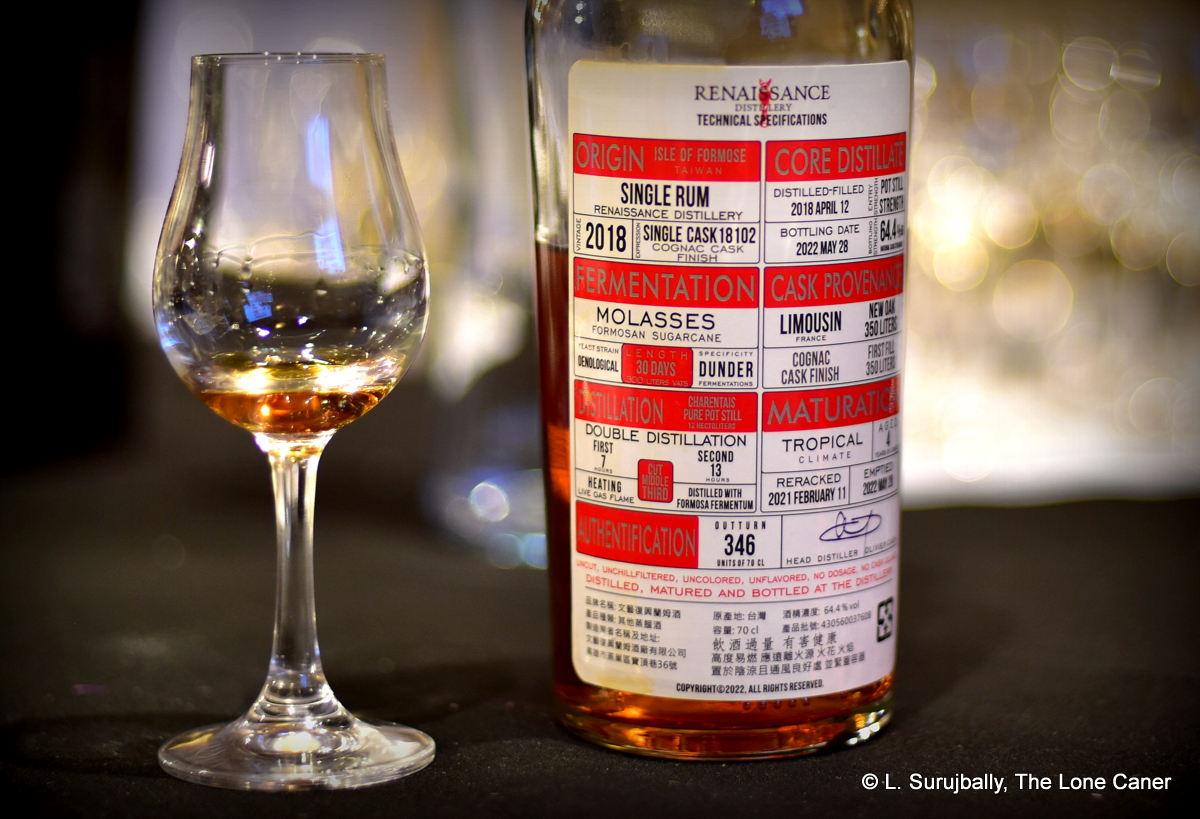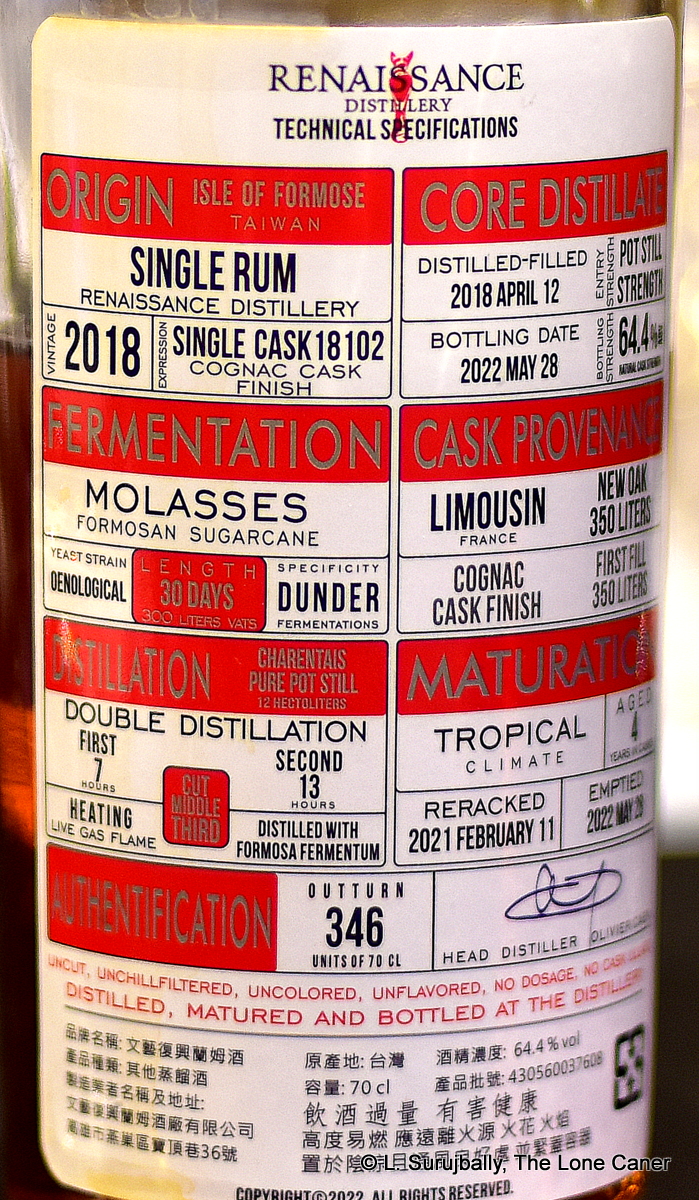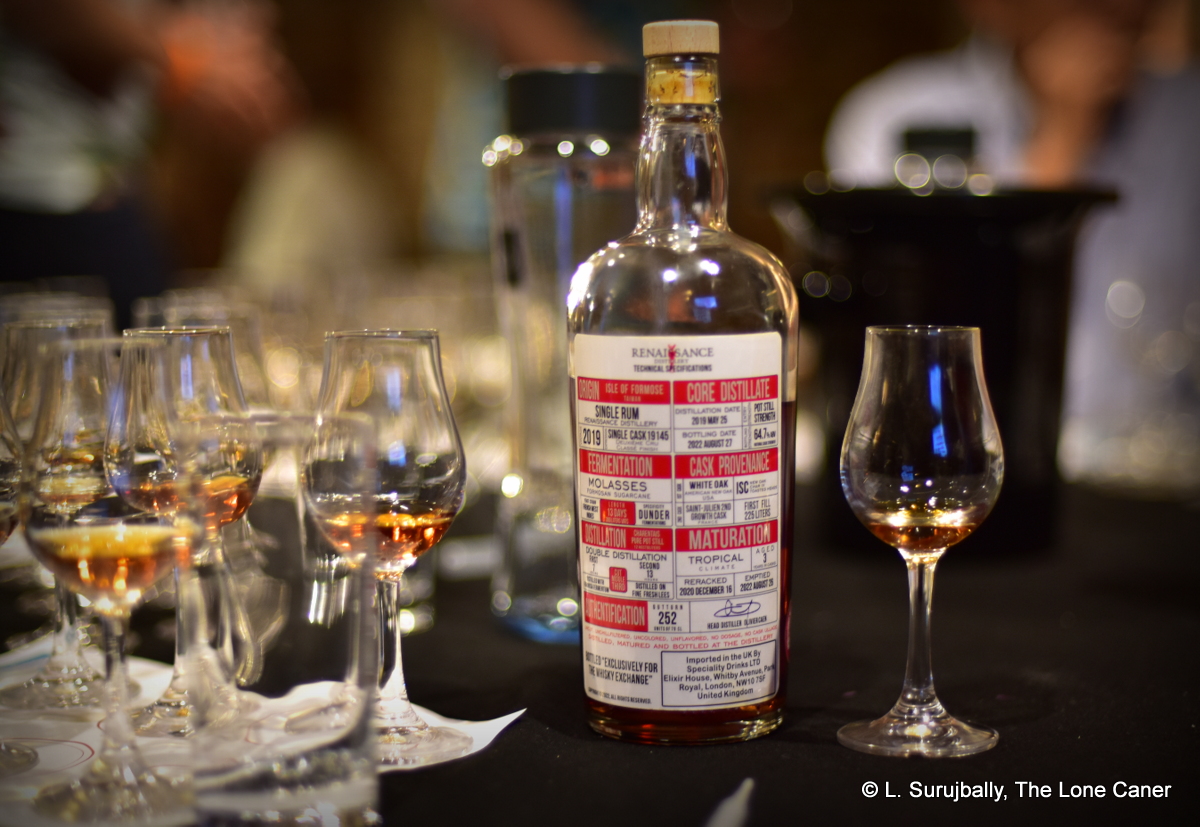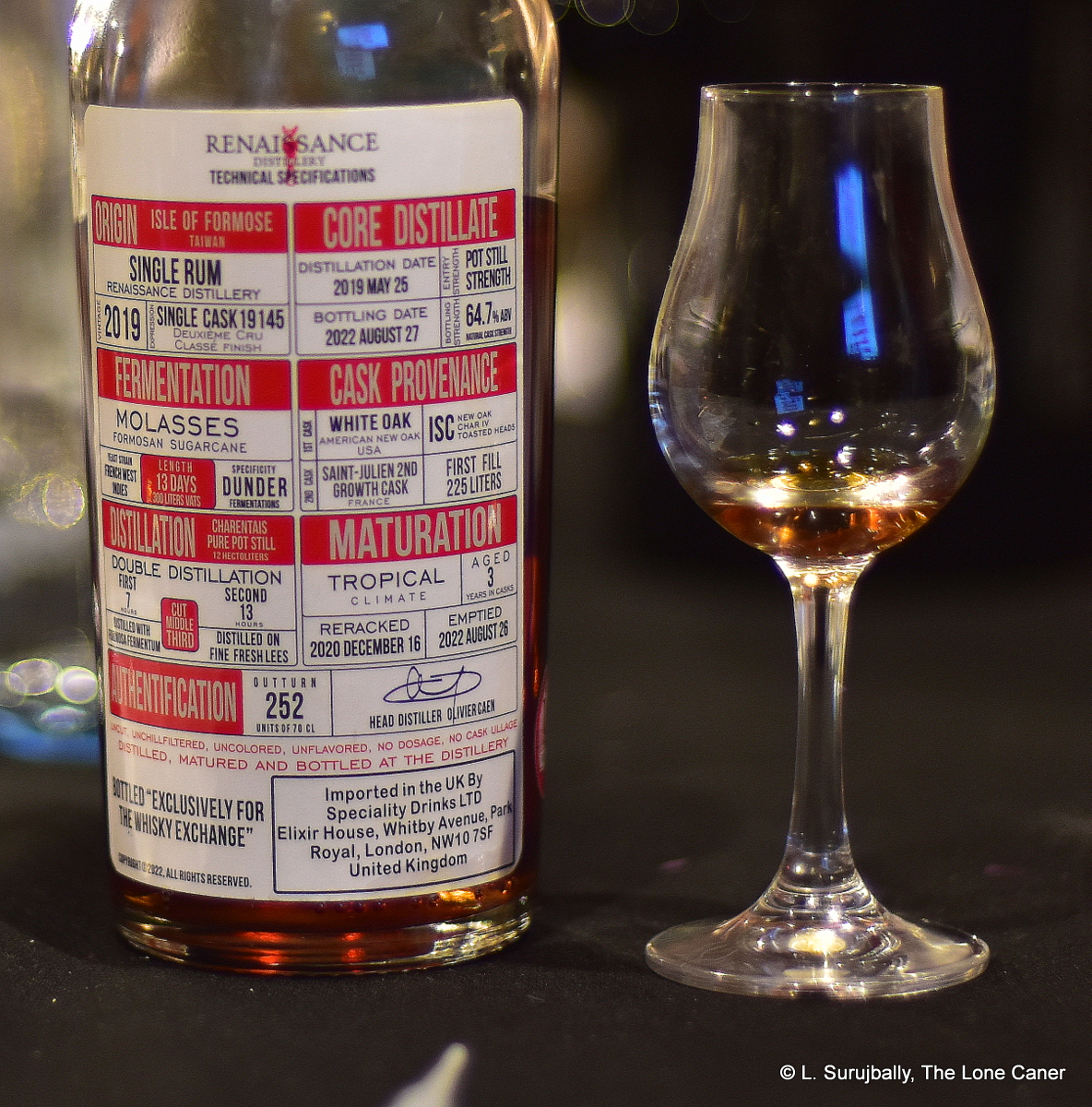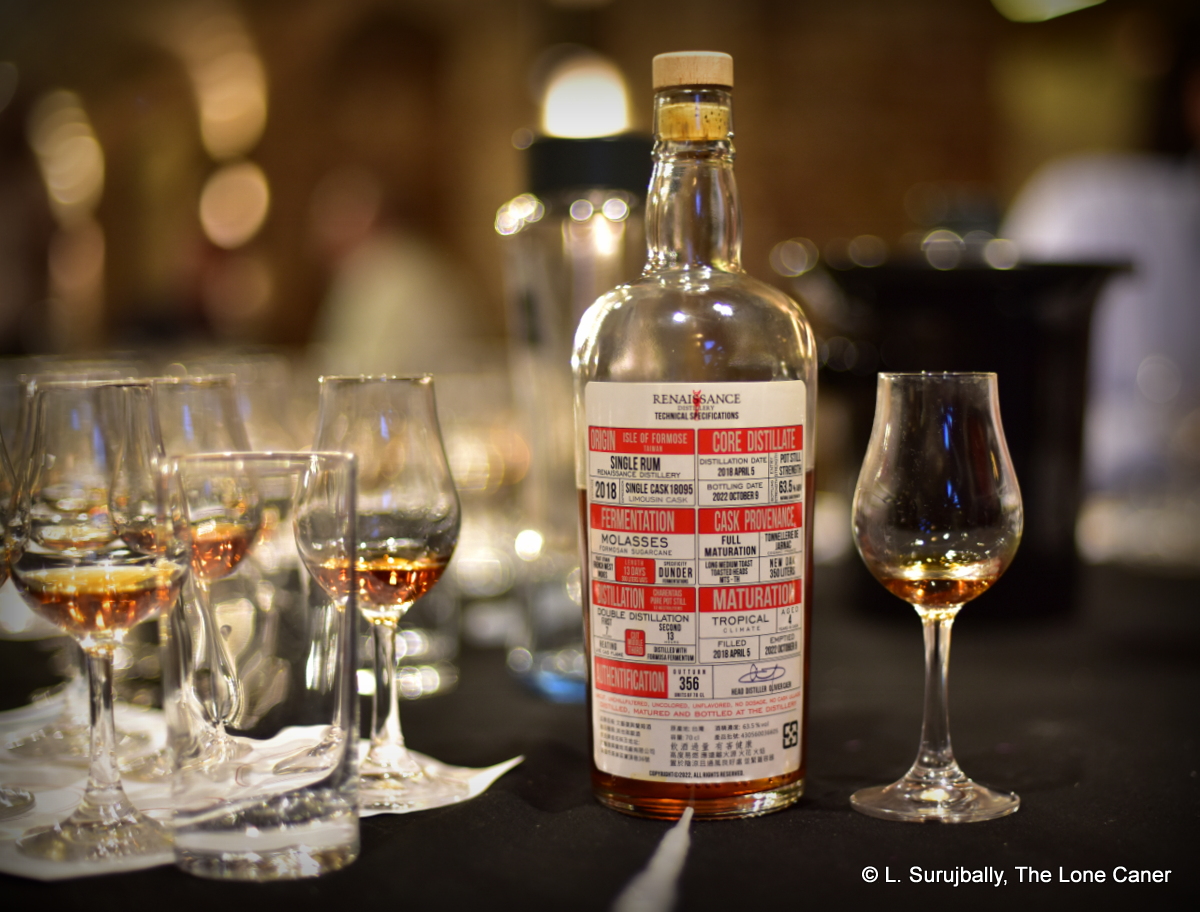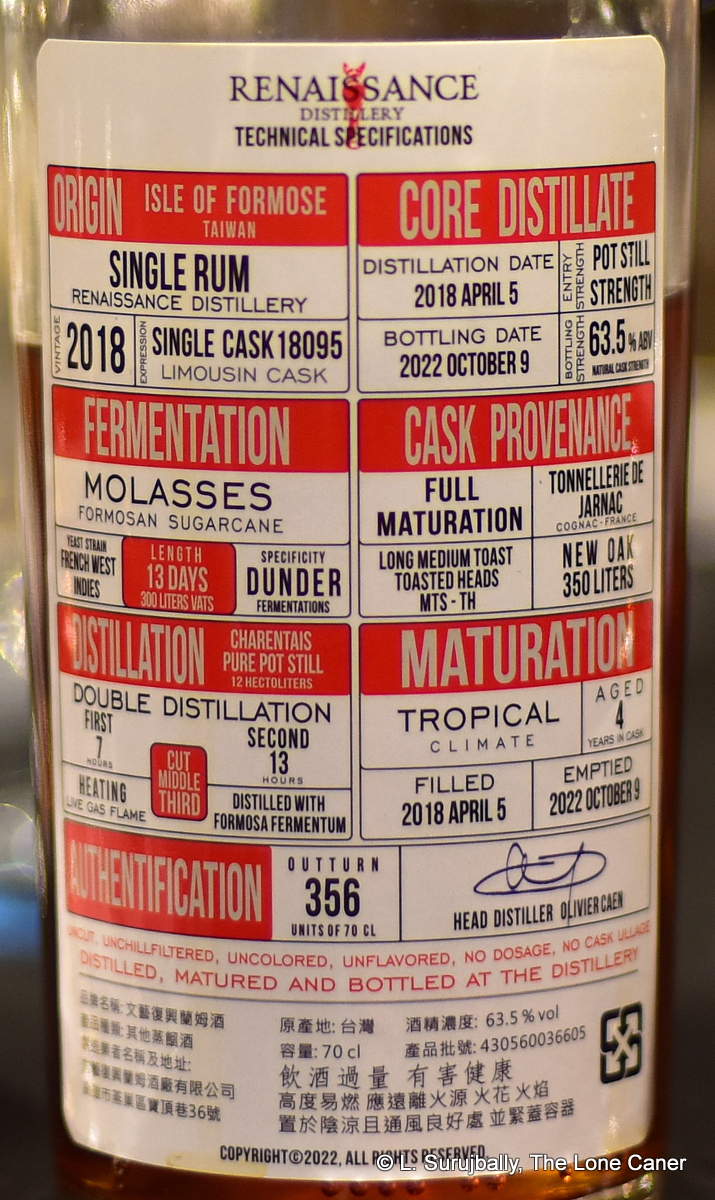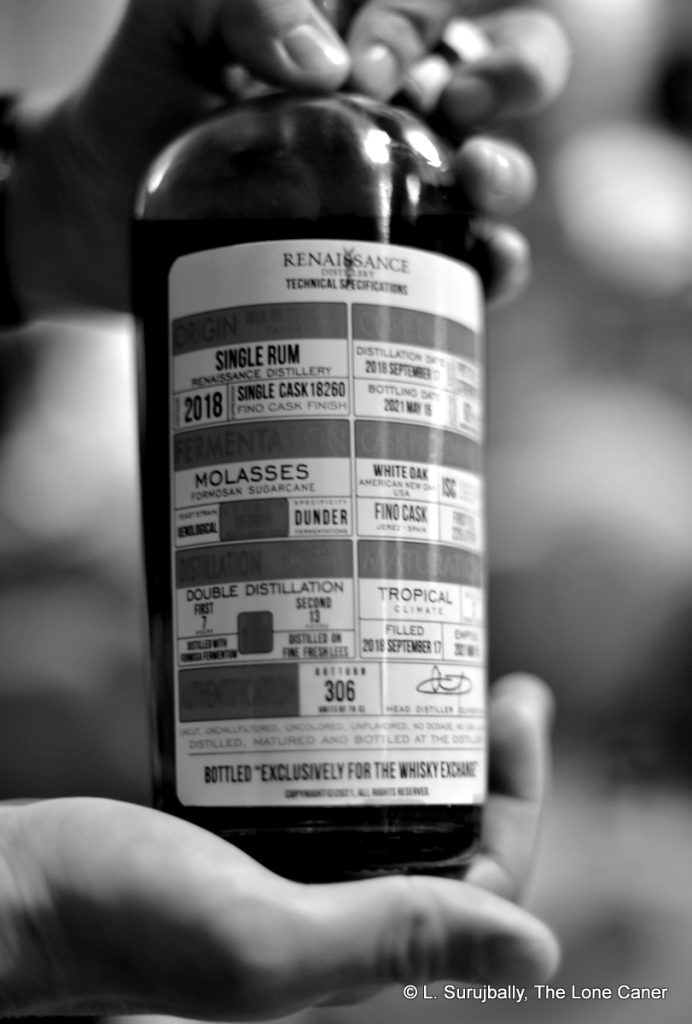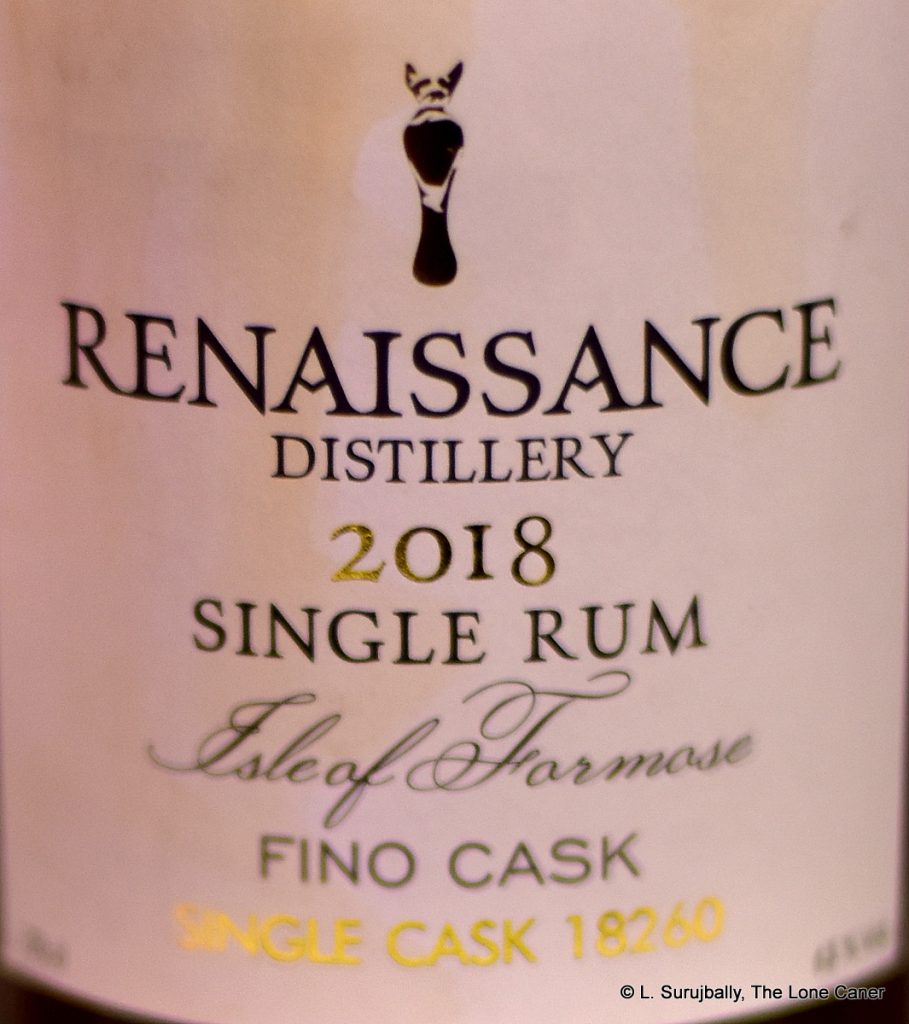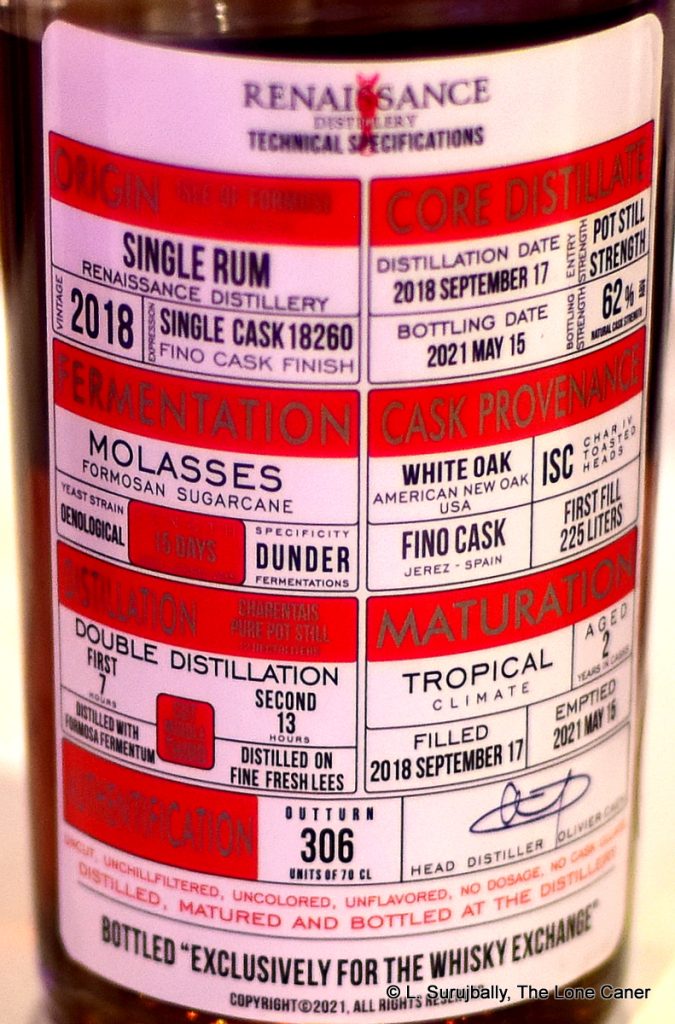This is the fifth and final review in the short series (of six – I have tried one before) where we look at some rums released by the Taiwan based Renaissance Distillery, which were on display in a 2023 TWE Rumshow masterclass dedicated to the company. It should be noted that the company has issued scores of full proof single cask releases already, so at best this scratches the surface.
For all its rather off-putting connotations to those who don’t know the term, noble rot is a controlled fungus infestation of grapes that go on to produce a particularly fine and concentrated sweet wine. Perhaps it is no surprise then, that a wine lover like Olivier Caen, one of the founders of the Taiwan-based Renaissance Distillery, sourced barrels of this kind of wine in which to age some of his rum. I sometimes think it’s his intention to try them every possible kind of cask in existence, but one can’t quibble with the results, because in many cases what comes out the other end is really kind of great.
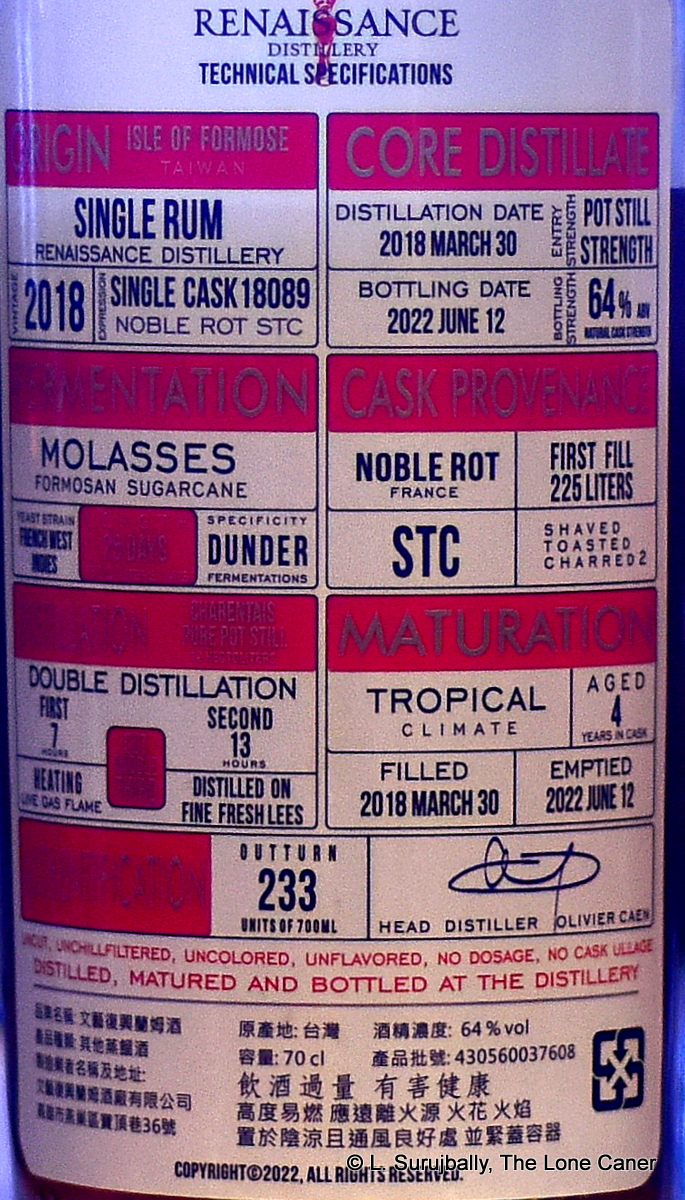 By now we have come to know a fair bit about the production techniques of the small distillery just by perusing the labels, and this one is no different. The cane is their own, planted by the distillery, sent to a nearby factory to be crushed and turned into molasses which is then fermented with any one of a number of different yeast strains (a French West Indian one in this case, and for just shy of four weeks). There is the double distillation in the Charentais pot still (the second pass is on the lees) and then the distillate is set to age in a first fill noble rot barrel that has been “shaved, toasted and charred”. Four years later and et voilà, we have this rum, bottled to showcase ever percentage point of its 64% strength.
By now we have come to know a fair bit about the production techniques of the small distillery just by perusing the labels, and this one is no different. The cane is their own, planted by the distillery, sent to a nearby factory to be crushed and turned into molasses which is then fermented with any one of a number of different yeast strains (a French West Indian one in this case, and for just shy of four weeks). There is the double distillation in the Charentais pot still (the second pass is on the lees) and then the distillate is set to age in a first fill noble rot barrel that has been “shaved, toasted and charred”. Four years later and et voilà, we have this rum, bottled to showcase ever percentage point of its 64% strength.
With that kind of potential – local sugar cane molasses, long fermentation, double pot still distillation, first fill charred barrel – one would expect no shortage of aromas and flavours jostling and shoving to get out the gate and strut their stuff, and indeed that’s what we get. The nose, for example, is delectable – it’s crisp, very clear, and reminds me of a dry Riesling, with notes of red grapefruit, grapes and some tart, sharp ripe fruits – apples, cider, red currants and some laid back light florals. There’s a slight creaminess in the background, like yoghurt; and salt butter spread over hot croissants fresh from the oven. Nice.
The strength does the rum no harm and the four years of ageing has tamped down the excess reasonably well. So it doesn’t hurt or display too much sharpness. It tastes slightly creamy, like salt caramel ice cream minus some sugar; a touch salty, and all the crisp fruits remain available to be enjoyed – apples, grapes, pears, apricots, peaches and even some ginnips and lychees. One can perhaps detect traces of coconut shavings and spices like vanilla and cinnamon, even mauby bark, which is nice, but it’s just a bit, here and gone quickly. Finish is long and epic, as is to be expected, clean and clear, quite spicy, mostly fruits and florals and even a touch of honey.
Overall then, not terribly different from others we’ve tasted, but every bit as good as most and better than some. This is a short review because I want to get to the summation of my observations and there’s nothing much more to add to the company bio or this rum you don’t already know. I should, however, close with the note that for me this was one of the best of the six, and I’d buy it if it ever turned up in my market. We don’t get so many unique and tasty rums at this strength from obscure markets as it is, so we need to treasure the ones we find.
(#1032)(86/100) ⭐⭐⭐⭐
The rums in this short series:
- 2018 2½ YO Taiwan Rum (Fino Cask) 62.5% – Cask #18260
- 2018 4 YO Taiwan Rum (Limousin Cask) 63.5% – Cask #18095
- 2019 3YO Taiwan Rum (Deuxieme Cru Classe) 64.7% – Cask #19145
- 2018 4 YO Taiwan Rum (Noble Rot STC) 64.0% – Cask #18089
- 2018 4 YO Taiwan Rum (Bas Armagnac) 63.2% – Cask #18035
- 2018 4 YO Taiwan Rum (Cognac) 64.4% – Cask #18102
Summing up – some general observations on the rums of the line
As the six reviews I’ve written make clear, I really like the company and its rums – they have placed Taiwan firmly on the map of quality rum making, and hopefully inspire others on the island to try their hand, to the point where it becomes a rum-geek’s destination the way the Caribbean is. It’s one of the most consistently good estate producers out there, the more so because they don’t have a single standard product out there, no blends, no regular five or ten year old that carries the flag, or appeals to the larger crowd. It’s all single barrel releases, like they were an indie bottler with a single client – themselves. I’ve yet to find a dog in the series.
The rums they make are of a uniformly high level of excellence, and while others have scored the various individual expressions lower than I have (or higher) depending on their personal tastes, few fail to concede the power and uniqueness of the overall line. The combination of local cane, different yeast strains, varied fermentation times, a smallish pot still, double distillation, and all those crazy barrels in which the rums are either finished or double matured, constitutes something of a profile enhancer. The rums always have a whole lot bopping around in the foreground while some weird sh*t is dancing the ragtime out back, and as if that wasn’t enough, they are almost always issued at cask strength, with all the intensity of flavour and aromas this implies.
That said, there are a few issues as well, of which the most important and oft-repeated – from a consumer’s perspective anyway – is the expense. I have zero patience for those in subsidised markets who grouse when a rum from somewhere else is over thirty dollars…but here they have a point. Renaissance’s rums are expensive, and at over a hundred bucks a pop for rums less than five years old, that’s a hard sell and a tough buy when there’s so much older stuff out there, of equally good value. It’s pointless to argue that taxes make up a large part of that, as do freight charges to get the things shipped all the way from the far east: optics are everything and until those prices become more affordable, the company’s excellent rums will remain a niche product for many.
Secondly there’s the unintended consequence of the very qualities that make the company’s name: the lack of a standard product. Consider another two highly-lauded relatively new estate producers: Hampden and Worthy Park. They gained a following with rums everyone could afford and which were widely available and then started to go upscale with more limited releases that channelled the variations imparted by different barrels and experiments in the production process. Renaissance took the reverse approach and started right away from this point without every going through the “standard product” stage and has issued nothing but premium releases. This to some extent hampers a broader recognition – oh sure, they have great word of mouth and I hope this small series raises their profile even more (because they deserve it) but how many people have actually tried them, or can?
Moreover, there is a subtler, more important effect of all the variations in releases which so delight the connoisseurs: the lack of a consistent, standard production model (like, oh, Hampden’s 8YO workhorse), and what this means is that there is nothing here that defines Taiwanese terroire specifically. There’s too much other stuff in the way. Consider how distinctive the traditional Caribbean and Latin American rums are, for their countries – you can tell apart a Jamaican, Guyanese and French island rum quite easily because they channel something intrinsic to their points of origin, such as the stills of Guyana, the fermentation of Jamaica or the cane juice origin of Martinique and Haiti. For all Renaissance’s quality, the short ageing in all those different barrels obscures what might one day help define Taiwanese rum, something that also hampers, say, Nine Leaves out of Japan…but not, in contrast, Cor Cor or Ryomi.
Where I see this is going, then, is that the distillery will continue to make waves in the high end market for the foreseeable future with those entrancing limited single barrel releases, especially if they get better distribution. Who knows, these early essays in the craft may one day be regarded like Velier’s famed Demeraras and Caronis – deemed to pricey at the time, always remarked on for their quality, appreciating astronomically in the years that follow.
At some stage though, as the company expands (and I think they will), I suspect that the scaling up of the distillery will result in the production of a “regular” Taiwanese blend in quantity, without the distraction of other enhancements and embellishments. Whether aged or unaged, juice or molasses, overproofed or living room strength, if the quality is retained and the taste is as good, their market is all but assured. If and when they ever do that, you can be sure that far more than just obscure bloggers like this one will be hungering for what they have produced.
